- Home
- Deborah Blum
Love at Goon Park: Harry Harlow and the Science of Affection Page 2
Love at Goon Park: Harry Harlow and the Science of Affection Read online
Page 2
The University of Wisconsin at Madison supported this book from the beginning, and in particular, the Graduate School provided funding for student researchers and summer salary so that I would have extra time to work on the manuscript. I was blessed with some dedicated and extremely smart graduate students who read old psychology texts, tracked down long-lost contacts of Harry Harlow, and made a real contribution to the depth of this book. They are a group of outstanding young journalists named Tina Ross, Brennan Nardi, Suzanne McConnell, Krishna Ramanujan, Morgan Hewitt, and Maggie Miller.
I owe an infinite debt of gratitude to Robin Marantz Henig, Kim Fowler, and Peter Haugen, who read the book in its earliest, most chaotic version and helped turn it into an actual story. George Johnson and Shannon Brownlee were enormously helpful with some of the trickiest chapters in the book.
I am blessed, as always, in my agent, Suzanne Gluck, who believed in the Harlow story from the start and helped me see its potential as well. And I am doubly blessed in having the best possible editor in Amanda Cook. Amanda is such a good editor, so smart and so supportive, and so gifted in her ability to improve a story, that I have been congratulating myself on my good fortune almost since I started the book. Perseus’s talented and meticulous production staff improved and clarified the story I wanted to tell and then packaged it beautifully and I would particularly like to thank copy editor Jennifer Blakebrough-Raeburn, who has a wonderful literary mind, and senior project editor Marietta Urban. And I also had the good fortune of being teamed with Perseus’s terrifically smart publicist Leigh Weiner.
Last, but not least, as they say: This book is about family and love and partnership and relationships and there is no way that it would have been finished without the love and support of mine. I’ve been wrestling with the Harry story for so long now that both my children, Marcus and Lucas, also call him by his first name. So does my husband, Peter Haugen, who has held down the home front too many times while Harry, my laptop, and I were hunkered down in my basement office together. The three of them kept me from disappearing entirely into the book, partly because they never fail to remind me that nothing matters more than those we love.
PROLOGUE
Love, Airborne
IN A WHITE ROOM, TWO MEN are talking about love. One of them stands keenly upright, pressed into a deftly cut suit. The other is less elegant: slight, dark-haired, a little stoop-shouldered, shrugged into a floppy lab coat. Both their voices sound hollow in the pale space around them. The room seems glossy with cold. Nearby counters are polished to an icy sterility. Metal and glass equipment gleam bluish in the wash of fluorescent lights. Against this background—chilled essence of laboratory—the speakers sound like men out of place and time, their conversation absurdly soft with talk of poets and love songs, starry nights, and daytime dreams.
Or perhaps they are just ahead of their time. At this moment, in the close of the 1950s, no one stands in a laboratory to discuss love in these terms. Even psychologists—those perpetual students of human behavior—aren’t lobbying to include warmhearted affection among the charts and the graphs and the calibrated machinery. Experimental psychologists have been rejecting the notion of love as good research material for years. Powerful psychologists have made it clear that fuzzy and sentimental emotions are the stuff of fiction, not of research reports. Researchers who study human relationships prefer to avoid using the l-word. You can still open the acclaimed history of Psychology in America, by Stanford’s Ernest Hilgard, and find the word “love” missing entirely from the subject index.
So it’s a professional gamble for the small man in the lab coat even to have this conversation. He is an experimental psychologist—a stubborn, scruffy, middle-aged researcher named Harry Frederick Harlow who happens to believe that his profession is wrong and doesn’t mind saying so. Of course, he’s often been told that the problem lies with him. The unexpectedly outspoken son of a poor family from Iowa, he’s developed a habit of scrapping with mainstream psychology. Professor Harlow has already been asked to correct his language: He’s been instructed on the correct term for a close relationship. Why can’t he just say “proximity” like everyone else? Somehow the word “love” just keeps springing to his lips when he talks about parents and children, friends and partners. He’s been known to lose his temper when discussing it. “Perhaps all you’ve known in life is proximity,” he once snapped at a visitor to his lab at the University of Wisconsin in Madison. “I thank God I’ve known more.”
How close do you have to be standing to connect with a person? Harry liked to ask that question, drawling it out with a nice sarcastic edge. Three inches? Four? Could you build a relationship at a distance of six inches? His colleagues, as they told him, saw no need for mockery. He could choose other scientific terms if he didn’t like proximity. The scientific vocabulary also offered attachment, conditioned response, primary drive reduction, stimulus-response, secondary drive reduction, object relationship—the last if you wanted to be Freudian about it. Why bring love into it?
And now here’s Harry Harlow, on national television of all the damned places, with his intimate vocabulary and his insistence on emotional relationships. The conversation in the laboratory appears on a CBS show called The Measure of Love. The program is the 1959 premier of Conquest, the network’s Sunday evening science show. In the entire half-hour presentation, the word “proximity” never crosses Harry’s lips.
Charles Collingswood, a respected CBS journalist, is the man in the elegant suit. On camera, Collingswood stands authoritatively tall. Harry Harlow looks small by comparison, dwarfed inside the ubiquitous lab coat. He has a square face, dark eyes under near straight brows, short dark hair slicked determinedly back. His voice is a little high-pitched, smoother than Collingswood’s rumble.
But the voice of science is unexpectedly the voice suitable to a pulpit, slightly singsong in its cadence. There’s music in the way Harry assures us that it is possible to make real what had previously been “undefinable and unmeasurable.” As he talks, one might even believe that love is substantial enough to be decanted into test tubes. When it comes to love, “your guess is as good as mine,” Collingswood says to the audience, “but guesswork is not the way of science and this,” and his gray granite voice deepens a notch, “this is a scientific laboratory.” At the start of the program, Collingswood stands holding a monkey in one hand. The monkey is a bright-eyed baby, a natural mohawk of fluff crowning its head. It nestles in Collingswood’s curved hand like an egg in a cup, tiny fingers curled over the edge of his palm. Harry Harlow, after all, is a primate researcher, a pioneer in the emerging science of understanding monkey behavior as a way to understand us. Collingswood gestures slightly to emphasize that point, the monkey riding the sweep of motion: “In this laboratory, there are approximately 120 rhesus monkeys; the subject of a study that wants to know the answer to the question: What is an infant’s love for its mother?”
There’s little trace, here on Conquest, of what some would say is the off-camera Harry Harlow, none of his well-known irreverence. This is a man who when a graduate student points out a golden and luminous moon snaps: “Been there a long time. I’ve seen it before.” None of that wisecracking irritation shows now. This shiny faced, sweet-talking preacher of a scientist seems wholly absorbed by the beauty of the subject. The man on camera reveals little of the man who lives at the lab, dawn to dark, fueled by coffee, cigarettes, alcohol, and obsession. Okay, maybe the obsession slices through. He’s completely in the argument, trying to convince the world that if science will just pay attention, we could learn the measure of love, cup it in our hands, almost as Collingswood cradles the little monkey.
“Now, Mr. Collingswood, wouldn’t you say that if you frightened a baby, that if it went running to its mother, was comforted, and then all the fear disappeared and was replaced by a complete sense of security, that baby loved his mother?” he asks in that coaxing voice.
“Sure,” Collingswood replies, casually. Sure,
of course. Who wouldn’t believe that love was, at its best, a safe harbor—a parent’s arm scooping up a frightened child, holding it heart to heart? It’s hard to believe, in retrospect, how many powerful scientists opposed this idea. “In psychology, love was smoke, mirrors, bullshit, and that was exactly what everyone was telling Harry,” one of Harry’s graduate students recalls. It took courage, probably more than anyone at CBS appreciated, to look straight into the camera and contradict the professional standards of the time.
There’s a moment on the Conquest show when one of the Wisconsin experiments is displayed. It creates exactly the sequence that Harry described. The scientists send out a mechanical monster, maybe eight inches tall, that resembles a cross between a space alien and a dragon with its flashing eyes and black bat wings. “It looks diabolical,” says Collingswood. “That’s just the way a baby monkey feels about it,” replies Harry—and almost as he speaks, the baby monkeys take one look at this terror and go airborne.
They fly like guided missiles—a perfect arc of child to mother. Look, says Harry, mouth curving. One of the baby monkeys, now firmly lodged against mother, is screeching angrily at the monster, threatening it: Back off, you. I’m with my mother now. If a measure of love is the way we shelter each other, you can mark it clearly in that fluid and beautiful flight line to home.
The two men watch silently. Harry doesn’t have to add anything. He knows it, too. He can step back and let the relationship reveal itself. Baby to mother, arrow into the heart. He does have a take-home message though, as he stands here in his baggy coat and talks up the importance of simple affection. The message has enough potency that you can understand why it might be worth contradicting more than fifty years of scientific dogma.
In this conversation about love, the two men have different goals. Charles Collingswood has come to Madison, Wisconsin, to illuminate an unusual experiment and to make some good television. Harry Harlow is there to help him. But he’s also trying to foment a small revolution, taking the chance to provoke the argument even during this flickering black-and-white moment on Sunday television.
We begin our lives with love, Harry says, looking directly at the camera; we learn human connection at home. It is the foundation upon which we build our lives—or it should be—and if the monkey or the human doesn’t learn love in infancy, he or she “may never learn to love at all.” He looks absolutely confident in what he’s saying—as if there were no furious ongoing debate, as if he spoke for his profession. Arguing his point as an outsider is a skill that Harry Frederick Harlow has honed since childhood. He’s more than willing to stand on behalf of that improbable, unreliable, elusive emotion called love, to gaze into the camera lens and say: Listen to me. I’ve got something that you need to hear.
ONE
The Invention of Harry Harlow
Parental love, which is so touching and at bottom so childish, is nothing but parental narcissism born again and, transformed though it be into object-love, it reveals its former character infallibly.
Sigmund Freud, 1914
HE WASBORN OUTOF PLACE, a dreamer and a poet planted in the practical Iowa earth. As unlikely as a rose in a cornfield. The childhood of Harry Frederick Israel—he would become Harry Harlow, but that’s a later part of the story—often made him laugh in retrospect. He was such a funny little misfit of a child, hemmed in by the orderly fields, too often dreaming down those rows of green and gold to the point where they met the rim of the sky.
This was southeastern Iowa, after all. Everyone grew up amid the cornfields. At the dawn of the twentieth century, the landscape was a study in domestication. Paradoxically, that very neatness made Iowa a revolutionary corner of the country. Not even a hundred years before, the land had belonged to lynx and wolf, deer and buffalo, the elusive catamount, and the bright copper fox. Tall-grass prairies and wooded hills, undisciplined rivers that had never seen a levee, forests with familiar trees such as maple and birch and forgotten ones such as linn and ironwood. The Fox and the Sac tribes once hunted here, gathered wild plants, quarreled over territorial boundaries, called it home.
The old settlers—Iowans think the term “pioneer” sounds too transient—began transforming the land in the early nineteenth century. The little town of Fairfield, where Harry was born many years later, was chartered in 1836, neatly laid out around a traditional town square. For decades, it retained a frontier quality. Until the 1870s, hogs were allowed to run through the square. When the mayor finally insisted that livestock be penned, pig owners angrily protested this affront to liberty. People paid their bills with what they could grow or raise. The town doctors accepted everything from chickens to tomatoes. The pharmacies on the square sold Indian remedies to their customers, tidily packed cloth bags with chamomile flowers for measles and slippery-elm bark for pneumonia.
Science was something distant, not quite real and not all that important. “Few knew or cared that the world was filled with innumerable fascinating creatures or that the history of the earth was written in the rocks beneath their feet,” wrote the Fairfield historian Susan Fulton Welty in a loving tale of her hometown. In the late nineteenth century, some Fairfield high school students formed a science club. They were enthusiastic, but they found the subject mysterious at best. One of the first meetings raised the question “Is a Bat a Bird?” The members were mostly nature collectors. They packed their clubhouse with pinned insects, dried flowers, the brittle remains of ferns and mosses, and assorted bones. At one point, club members assembled almost the entire skeleton of a horse, built from bleached bones found tumbled in a nearby pasture.
By the time Harry Israel was born, the frontier had been tidied away. The town square was neatly paved. The Sac and the Fox had mostly vanished, pushed to the west. The herbal remedies had been replaced by a red-brick hospital and more European-style medicine. The woodlands and feathery fields were plowed, tilled, and rotated into submission. Even the science enthusiasts had given up bone hunting. The local high school now taught the study of nature, “with especial attention to the highest of vertebrates, Man himself.” Harry would have preferred it just a little less, well, predictable. Years later, he would confess that completely orderly science bored him. He could never quite accept rules as absolute. He was never really convinced that “Man himself” was an example of evolutionary perfection. A work in progress, maybe. He would have been happy to argue the point—if it had been open for debate in Fairfield. His family would have said that Harry was born to argue. So would his peers. When he graduated from high school, this quote appeared under his yearbook picture: “Though rather small, we know most well, in argument, he doth excel.”
He was born on a Halloween evening, October 31, 1905, at his family home in Fairfield. “Within thirty minutes I had precipitated a violent family quarrel,” Harry once wrote. His Aunt Nell had come all the way from Portland, Oregon, and wanted to hold the baby first. But his two older brothers begged her to take them on a quick trickor-treat outing. When the three of them returned, baby Harry was lying cozily in his Aunt Harriet’s lap. “This was a situation in which better late than never did not pertain,” Harry would joke later. Harriet lived just around the corner in Fairfield. Nell had traveled hundreds of miles. And the ungrateful baby’s parents had named the child Harry. In family lore, the story of his birth always resounded with the ensuing thunder.
“Another memory which I do not have happened when I was three,” Harry wrote years later in an unpublished memoir. The entry was typical of the way he recounted his childhood—always flippant about growing up in Iowa. As he told the story, when he was a little boy, he owned a porcelain child’s potty, which he loved. He would carry it around the house with him. One day, according to his mother, “guided by uncontrolled scientific curiosity, I dropped a large stone on the potty’s bottom to see what would happen.” He sobbed over the pieces for days afterward. An incurable punster for most of his life, Harry wrote that his grief was probably caused by his having hit “rock bott
om.”
His parents were Alonzo Harlow Israel and Mable Rock Israel. If Harry was something of a misfit, that standard was perhaps first set by his father. Lon Harlow—he loathed the name “Alonzo” and as an adult refused to respond to anyone who called him that—had hoped to be a doctor. He gave that up, though, dropping out of medical school in his third year to marry Mable Rock. Lon never quite found anything else that he liked as much as the study of medicine. He reluctantly tried and happily abandoned farming. He tinkered with what Harry called “intermittent, unsuccessful inventing.” Lon experimented with home appliances, and once even developed a small washing machine. He dabbled at running a garage and battery business, teaching himself about mechanics by reading books and manuals in a weekend frenzy. He started a small real estate business with his father. Eventually, Lon and Mable bought a general store in a small town near Fairfield and settled there. Harry’s parents had been married for ten years and were in their mid-thirties when he was born. At the Fairfield public library today, there is an archived photo of Lon on his wedding day: a slim man with a pointed chin, dark eyes under deep brows, a thin mouth just tilted into a smile at the corners. There is also a photo of Mable wearing a lacy white dress that seems to float at the edges. Mable was barely five feet tall. In the picture, she is as delicate as a fairy, fine-boned and graceful in her posture, her shining dark hair pulled smoothly back from a small, rather beautiful face. The Israels had four sons, in this order: Robert, Delmer, Harry, and Hugh. The boys all had their mother’s slight build, their father’s brown eyes and heavy eyebrows. In Harry’s face, one can also see Mable’s finely drawn features and slightly squared, stubborn chin.

 Love at Goon Park: Harry Harlow and the Science of Affection
Love at Goon Park: Harry Harlow and the Science of Affection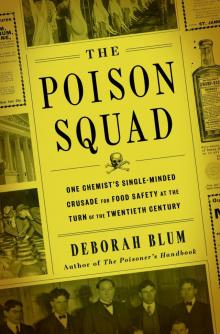 The Poison Squad
The Poison Squad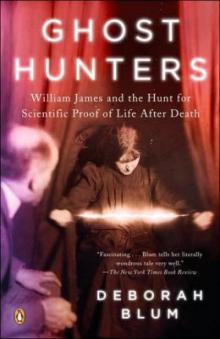 Ghost Hunters: The Victorians and the Hunt for Proof of Life After Death
Ghost Hunters: The Victorians and the Hunt for Proof of Life After Death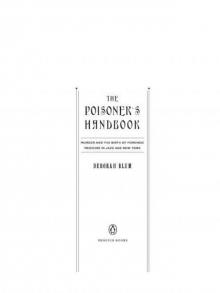 The Poisoner's Handbook
The Poisoner's Handbook Angel Killer
Angel Killer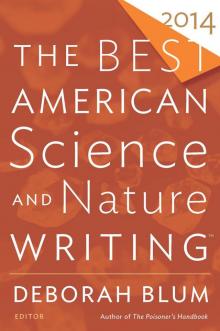 The Best American Science and Nature Writing 2014
The Best American Science and Nature Writing 2014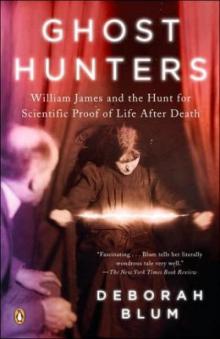 The Ghost Hunters
The Ghost Hunters Love at Goon Park
Love at Goon Park